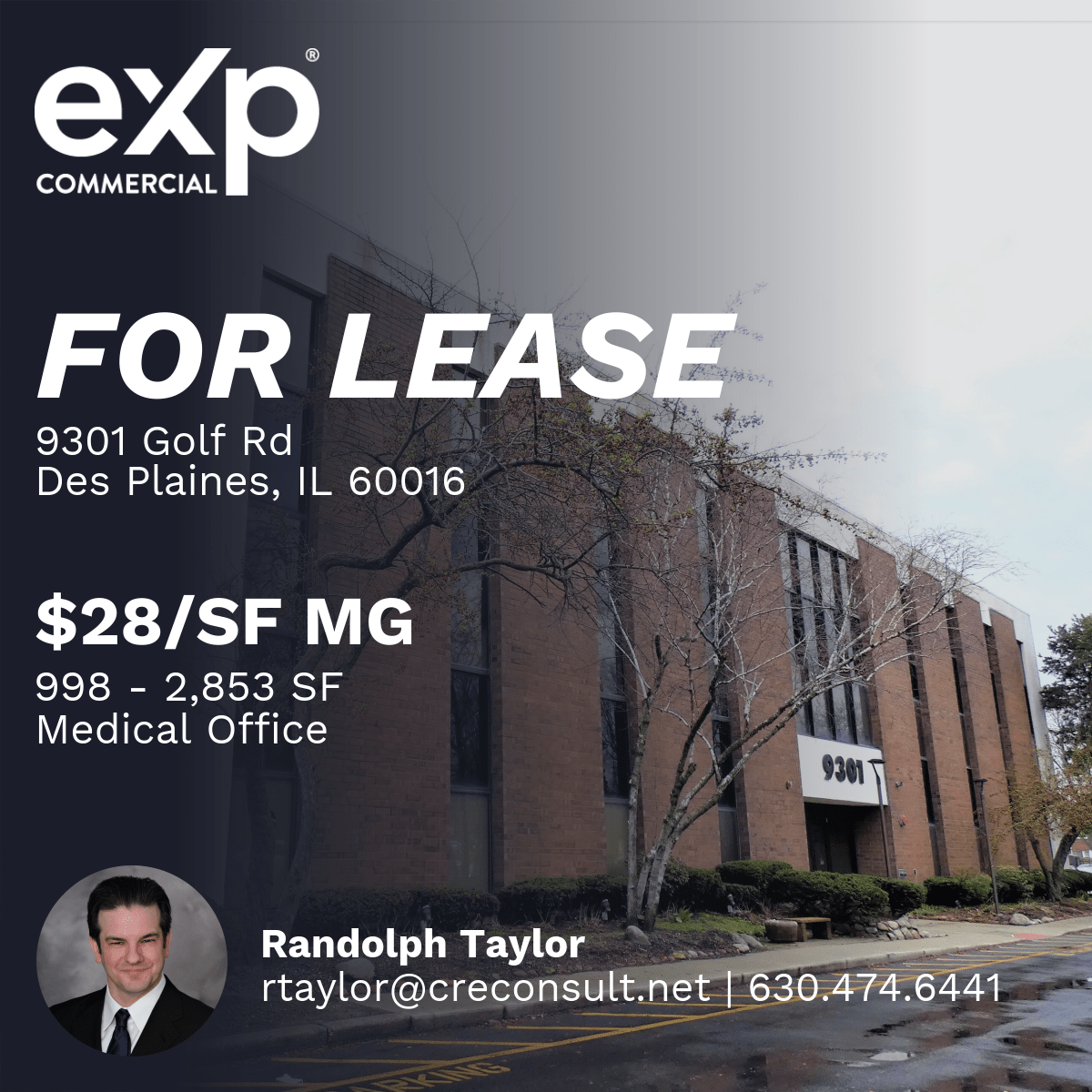9301 West Golf Rd | Des Plaines, IL 60016
Broker: Randolph Taylor rtaylor@creconsult.net | 630.474.6441
https://www.creconsult.net/golf-sumac-professional-building-medical-office-space-for-lease-9301-golf-rd-des-plaines-il-60016/

eXp Commercial is one of the fastest-growing national commercial real estate brokerage firms. The Chicago Multifamily Brokerage Division focuses on listing and selling multifamily properties throughout the Chicago Area and Suburbs.


After the strong economic rebound in 2021, growth in the U.S. has slowed in the face of rising inflation, the household income squeeze, and geopolitical events. In commercial real estate, third-quarter 2022 data showed slowdowns in the apartment and office sectors, while industrial and retail retained strength.
Multifamily absorption and rent growth decelerated in 2022, with absorption in the 60,000–70,000-unit range. That’s below pre-pandemic levels. In the meantime, rents rose year over year, but at a slower pace than a year ago. However, multifamily housing demand remains strong. Given rising mortgage rates and home prices, people may be forced to rent for longer due to decreasing affordability.
As the country navigates hybrid work, the office sector continues to struggle. In Q3 2022, about 1.34 million more square feet of office space was vacant and placed on the market than was leased. Although more people returned to their offices, after four quarters with positive net absorption, demand for office space dropped. As a result, the market’s net demand for office spaces decreased relative to supply, and the national vacancy rate rose to 12.4% in Q3 2022 from 12.3% in the previous quarter. The office sector has the highest vacancy rate across all sectors.
Although spending slowed this fall, it remained strong in Q3 2022, driving growth in demand for retail spaces for the seventh straight quarter. Retail sales, excluding gas, auto, and non-store retailers, advanced to $383 billion in August, a 19% increase from August 2019. As a result, net absorption increased to 23.3 million square feet in Q3 2022, a 22% increase from the second quarter. Neighborhood retail that offers in-person services continues to advance even faster. Net absorption for neighborhood centers rose by 35 percentage points compared to the year’s second quarter.
Demand for industrial property remains robust. Net absorption was nearly 425 million square feet in the 12 months ending in Q3 2022. Although demand may have tapered, the volume of industrial space absorbed continues to be double that of pre-pandemic times. As a result, this sector had the lowest vacancy rate in Q3 2022, at 4%.
With such strong demand, rent growth continues at historic highs, rising 12% year over year in Q3 2022. Rents are rising even faster for logistics space, at 13.5% year over year.
Source: Inflation War Take Their Toll
https://www.creconsult.net/market-trends/inflation-war-take-their-toll/
Source: What is Debt Yield and How Does it Apply in Commercial Real Estate
https://www.creconsult.net/market-trends/what-is-debt-yield-and-how-does-it-apply-in-commercial-real-estate-2/
DMG Capital, the multifamily investment affiliate of Chicago-based Daniel Management Group (DMG) completed the acquisition of Alice Mae Court, a multifamily townhome portfolio in Orland Park, Illinois, for $5.36 million. Alice Mae Court will be marketed by DMG affiliate DMG Leasing and professionally managed by DMG.
“This acquisition allows us to strategically add rental townhomes to DMG Capital’s multifamily portfolio while at the same time maintaining our disciplined investment focus of pursuing properties that are well-located with strong revenue growth potential,” said DMG Capital President and Co-Founder Roger Daniel. “Alice Mae Court is an optimal opportunity as it is new, high-end construction that is well-located in highly desirable Orland Park directly across from Centennial Park and just steps from the 153rd Street Metra Station.”
Alice Mae Court consists of 16 townhomes with a mix of large three- and four-bedroom units that include high-end finishes throughout, in-unit laundry, private balconies and attached two-car heated garage parking spaces.
The Alice Mae Court townhomes directly address the post-COVID demand for flexible living spaces that allow residents to live and work at home and have greater access to the outdoors. It also exemplifies the increased focus from investors on suburban properties that meet resident needs in sought after locations.
Source: DMG Capital acquires multifamily portfolio in Orland Park
https://www.creconsult.net/market-trends/dmg-capital-acquires-multifamily-portfolio-in-orland-park/
Off-Market Multifamily Sellers Are Leaving A Ton Of Money On The Table
Marketing a property can increase the sale price by up to 23%, which runs counter to the idea that off-market deals can achieve higher values because a buyer will be more aggressive to seal a trade.
The perception is when a seller has one buyer vying for an asset, that buyer is more aggressive and willing to pay a premium because they don’t want the seller to get into a bidding war for the property. Our research found the opposite.
This is a sign it is in the best interests of owners to undergo a marketing campaign for their properties. Growing allocations from institutional investors toward real estate are still driving a sizable pool of investors into bidding for multifamily assets, and a full campaign is what drives the premiums.
The job of a broker to create a competitive environment on behalf of the seller. Putting a building on the market determines the strongest buyer.
That may not be necessarily based on price alone. If one buyer has a higher-priced offer but weak financial backing, versus a buyer with a stronger track record, taking a lower offer is the way to go. It’s our job to give the seller those options and we do that by marketing properties and generating the highest number of qualified offers possible.
There are numerous case studies where a seller received an off-market bid, put it on the market, and the off-market buyer still bought the asset but at a higher price.
eXp Commercial Chicago Multifamily Brokerage focuses on listing and selling multifamily properties throughout the Chicago Area and Suburbs.
We don’t just market properties; we make a market for each property we represent. Each offering is thoroughly underwritten, aggressively priced, and accompanied by loan quotes to expedite the sales process. We leverage our broad national marketing platform syndicating to the top CRE Listing Sites for maximum exposure combined with an orchestrated competitive bidding process that yields higher sales prices for your property.
https://www.creconsult.net/market-trends/off-market-multifamily-sellers-are-leaving-a-ton-of-money-on-the-table/


The Commercial Real Estate Symposium will provide junior and senior agents and brokers with valuable insights on topics, including: international opportunities, capital and funding for small businesses in today’s market, how to attract investors, and much more.
Dates: April 25-26, 2023
Start Time: 9 a.m. - 4 p.m. CST
Location: eXp Commercial Campus
We look forward to seeing you in the metaverse!
Important: Please download the virtual eXp Commercial Campus prior to the event, and follow the instructions to login and create your avatar. Feel free to explore the campus before the event begins.
At the halfway point of the year, Cleveland, Cincinnati, Columbus, and Chicago have all seen rent growth well ahead of the national average....
